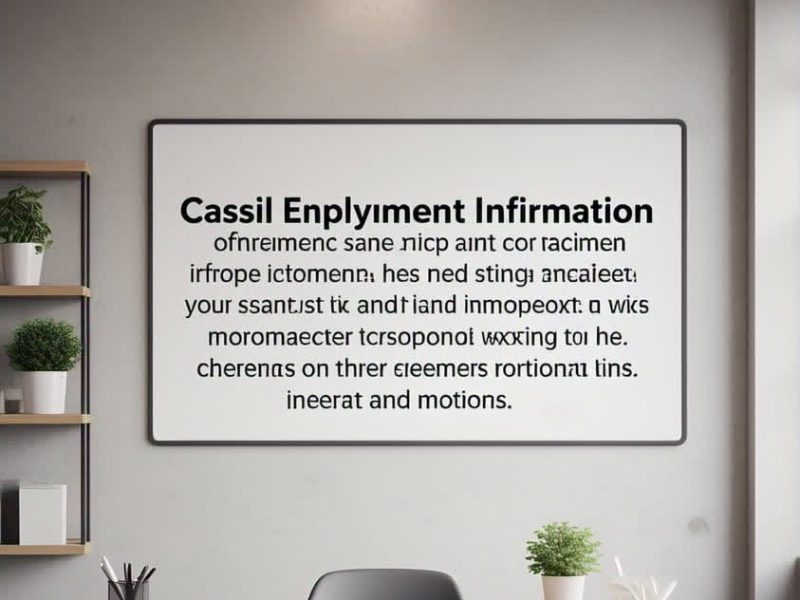
Casual employment is a vital aspect of the modern workforce, offering flexibility for both employers and employees. However, understanding the rights and obligations of casual workers is crucial for maintaining a fair and lawful workplace. One essential document that employers must provide to their casual staff is the Casual Employment Information Statement (CEIS). This article will explore the importance of the Casual Employment Information Statement, its contents, legal requirements, and why it plays a key role in protecting both employers and employees.
What Is the Casual Employment Information Statement?
The Casual Employment Information Statement is a mandatory document that employers must give to all casual employees in Australia. This statement, issued by the Fair Work Ombudsman, provides critical information about casual employment rights, including pathways to conversion from casual to permanent employment.
Employers must issue the Casual Employment Information Statement to casual employees at the start of their employment. It serves as a guide to ensure that workers are aware of their rights, entitlements, and potential opportunities for transitioning to permanent employment.
Why Is the Casual Employment Information Statement Important?
The Casual Employment Information Statement is crucial for maintaining transparency and fairness in the workplace. It ensures that casual employees fully understand:
•Their rights under the National Employment Standards (NES)
•Their entitlement to receive a loading in place of leave benefits
•The conditions under which they can request casual conversion to permanent employment
•The employer’s obligations regarding casual work arrangements
By ensuring that casual employees receive the Casual Employment Information Statement, employers help promote a well-informed workforce and reduce the risk of legal disputes. This document is especially important following recent changes to employment laws that define casual work more clearly and introduce a structured process for casual conversion.
Who Must Receive the Casual Employment Information Statement?
All casual employees in Australia must be given a copy of the Casual Employment Information Statement when they start working for a new employer. This requirement applies to:
•New casual employees – They must receive the statement before or as soon as they commence work.
•Existing casual employees – Employers must also provide the statement to current casual employees who may not have received it previously.
Employers can provide the Casual Employment Information Statement in either physical or electronic form, as long as employees can access and understand it.
Key Information Included in the Casual Employment Information Statement
The Casual Employment Information Statement outlines crucial details about casual employment rights. The most important points covered in the statement include:
1. Definition of Casual Employment
The statement defines a casual employee as someone who:
•Has no firm advance commitment to ongoing work
•Works on an irregular or uncertain basis
•Is entitled to a casual loading to compensate for the lack of permanent benefits
This definition was clarified by amendments to the Fair Work Act 2009, ensuring that casual work arrangements are properly recognized.
2. National Employment Standards (NES) for Casuals
Casual employees are entitled to certain rights under the National Employment Standards (NES), including:
•Two days of unpaid carer’s leave per occasion
•Two days of unpaid compassionate leave per occasion
•Unpaid community service leave
•The right to receive a Casual Employment Information Statement
•The right to request casual conversion after a specified period
3. Casual Loading and Pay Entitlements
Casual employees do not receive paid leave benefits such as annual leave or sick leave. Instead, they receive a casual loading, usually between 15% and 25%, to compensate for the lack of permanent entitlements. The Casual Employment Information Statement explains this loading and how it applies to casual workers.
4. Casual Conversion: Transitioning to Permanent Employment
One of the most important aspects of the Casual Employment Information Statement is the explanation of casual conversion. This means that eligible casual employees can request a transition to full-time or part-time employment if:
•They have worked for the same employer for at least 12 months.
•They have had a regular and consistent work pattern for at least six months.
•They are willing to accept a permanent position without significant changes to their role.
The employer must assess the request and provide a written response. However, they can refuse the request based on reasonable business grounds, which must be clearly outlined in writing.
5. Employer Obligations
The Casual Employment Information Statement also informs employers of their obligations, including:
•Providing casual employees with the statement at the start of their employment.
•Assessing casual conversion eligibility after 12 months of employment.
•Informing casual employees about their rights under the Fair Work Act.
Employers who fail to provide the Casual Employment Information Statement or ignore casual conversion requests may face legal consequences and potential penalties.
How to Provide the Casual Employment Information Statement
Employers can distribute the Casual Employment Information Statement in several ways:
•Printed copy – Handing a physical document to new casual employees.
•Email attachment – Sending a digital copy to the employee’s email address.
•Online employee portal – Uploading the statement to an internal HR system for easy access.
Regardless of the method, employers must ensure that all casual workers receive and understand the information provided in the Casual Employment Information Statement.
Common Mistakes Employers Make Regarding the Casual Employment Information Statement
Employers sometimes overlook their obligations regarding the Casual Employment Information Statement. Here are some common mistakes and how to avoid them:
1. Failing to Provide the Statement to New Employees
Many employers forget to give new casual hires the Casual Employment Information Statement at the start of employment. To prevent this, businesses should integrate the statement into their onboarding process.
2. Ignoring Casual Conversion Requests
Some employers fail to respond to casual employees who request conversion to permanent employment. Under employment law, employers must provide a written response within 21 days of receiving a request.
3. Misclassifying Casual Workers
Incorrectly classifying an employee as casual when they work regular and predictable hours can lead to legal issues. The Casual Employment Information Statement helps clarify what constitutes casual employment, reducing the risk of misclassification.

How the Casual Employment Information Statement Protects Employees
The Casual Employment Information Statement is designed to protect casual workers by ensuring they understand their work rights and employment entitlements. It empowers employees to:
•Know their pay and loading entitlements.
•Understand their rights to unpaid leave.
•Learn about casual conversion options.
•Recognize when an employer is not complying with the law.
By providing casual employees with the Casual Employment Information Statement, businesses contribute to a fair and transparent work environment.
The Role of the Fair Work Ombudsman in Enforcing the Casual Employment Information Statement
The Fair Work Ombudsman oversees compliance with employment laws, including the requirement for employers to distribute the Casual Employment Information Statement. Employers who fail to comply may face penalties and legal action.
Employees who believe their rights under the Casual Employment Information Statement have been violated can:
•Contact the Fair Work Ombudsman for assistance.
•Lodge a formal complaint if their employer does not provide the statement.
•Seek legal advice if their employer refuses to honor casual conversion rights.
Conclusion
The Casual Employment Information Statement is a crucial document that helps casual employees understand their rights, entitlements, and the possibility of transitioning to permanent employment. Employers must ensure they provide this statement to all casual workers at the beginning of their employment to maintain legal compliance and foster fair workplace practices.
By following the guidelines outlined in the Casual Employment Information Statement, both employees and employers can build a transparent, compliant, and mutually beneficial working relationship. Ensuring that casual workers receive and understand this document is essential for maintaining a fair and lawful workplace.
Employers should prioritize compliance with the Casual Employment Information Statement requirements to avoid legal issues and create a workplace culture that values employee rights and fair employment practices.





